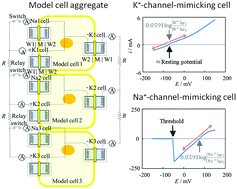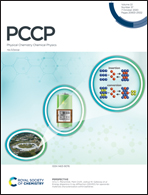Electrical cell-to-cell communication using aggregates of model cells†
Abstract
Cell-to-cell communication via a local current caused by ion transport is elucidated using a model-cell system. To imitate tissues such as smooth muscles and cardiac muscles, liquid-membrane cells mimicking the function of K+ and Na+ channels were made. Connecting these channel-mimicking cells (K+ channel and voltage-gated Na+ channel) in parallel, model cells imitating living cell functions were constructed. Action-potential propagation within the cell aggregate model constructed by multiple model cells was investigated. When an action potential was generated at one cell, the cell behaved as an electric power source. Since a circulating current flowed around the cell, it flowed through neighboring model cells. Influx and efflux currents caused negative and positive shifts of the membrane potential, respectively, on the surface of neighboring model cells. The action potential was generated at the depolarized domain when the membrane potential exceeded the threshold of the voltage-gated Na+ channels. Thus, the action potential spread all over the cell system. When an external electric stimulus was applied to the layered cell-aggregate model system, propagation of the action potential was facilitated as if they were synchronized.



 Please wait while we load your content...
Please wait while we load your content...